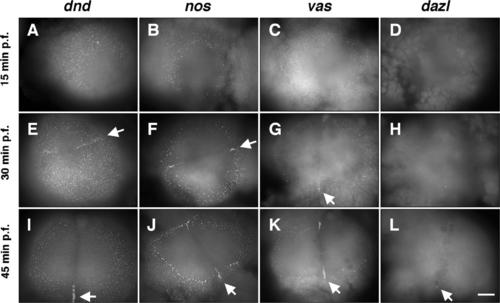Fig. 1
- ID
- ZDB-FIG-060419-6
- Publication
- Theusch et al., 2006 - Separate pathways of RNA recruitment lead to the compartmentalization of the zebrafish germ plasm
- Other Figures
- All Figure Page
- Back to All Figure Page
|
Endogenous patterns of RNA localization of dnd, nos1, vas, and dazl RNAs during the first cell cycle. Animal views of embryos fixed at progressively older stages of development (A?D: 15 min p.f.; E?H: 30 min. p.f.; I?L: 45 min p.f.) and labeled using FISH to detect germ plasm RNAs (dnd (A, E, I); nos1 (B, F, J); vas (C, G, K); dazl (D, H, L). (A?D) Immediately after fertilization, dnd, nos1, and vas RNA aggregates can be observed as a band at the animal pole, while dazl RNA aggregates are not initially present in the animal pole. (E?H) During the initiation of furrow formation, RNA aggregates for dnd, nos1, and vas begin to be recruited as a rod at the forming furrow (arrows in E?G). At this stage, dazl RNA is not yet detectable at the furrows (H). (I?L) As the furrow matures, there is an increase in the amount of dnd, nos1, and vas RNAs recruited at the furrow, and dazl RNA becomes detectable at the furrow (arrows in I?L). Scale bar in panel (L) represents 100 μm. |
| Genes: | |
|---|---|
| Fish: | |
| Anatomical Term: | |
| Stage: | 1-cell |
Reprinted from Developmental Biology, 292(1), Theusch, E.V., Brown, K.J., and Pelegri, F., Separate pathways of RNA recruitment lead to the compartmentalization of the zebrafish germ plasm, 129-141, Copyright (2006) with permission from Elsevier. Full text @ Dev. Biol.

